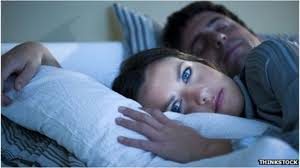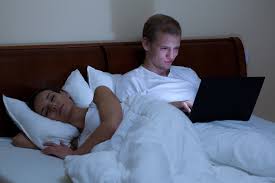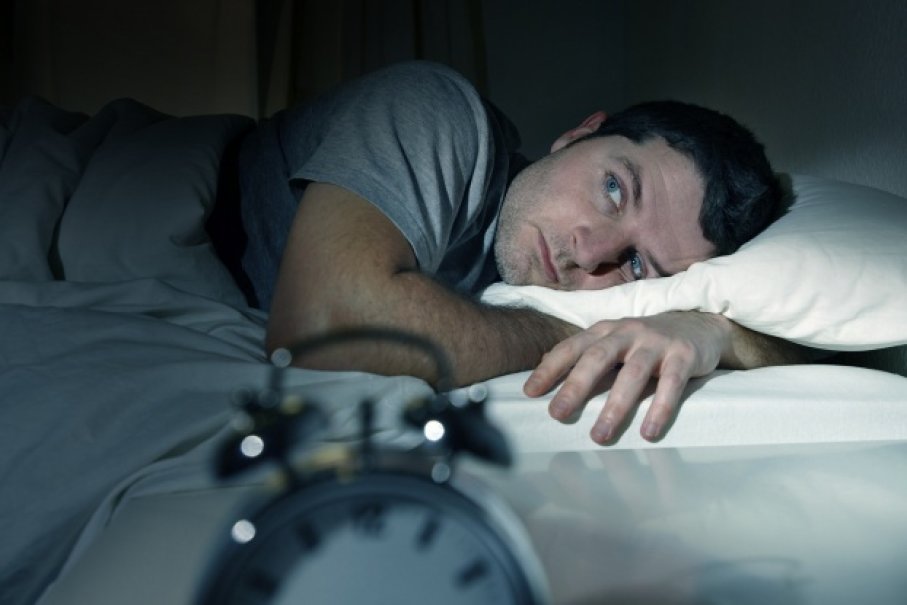More than one-third of American adults wake up in the middle of the night on a regular basis. Of those who experience “nocturnal awakenings,” nearly half are unable to fall back asleep right away. Doctors frequently diagnose this condition as a sleep disorder called “middle-of-the-night insomnia,” and prescribe medication to treat it.

We’ve been told by health experts, and it’s conventional wisdom, that we should sleep between seven and eight continuous hours a day as an adult. Yet, the assumption that an eight-hour block of sleep is the ideal or norm may be a myth. In addition, there it’s questionable to conclude that the amount of sleep for us has declined.Looking at the modern, developed world, it appears that sleep duration has not declined over the past 50 years. This finding challenges “the notion of a modern epidemic of insufficient sleep.”
Numerous studies have been published concerning the dangers of lack of sleep, to our brain and general health and longevity. In just one recent example, scientists have found that sleep allows our brains to clean themselves of toxins.
Yet, the insistence that “monophasic” sleep, with eight hours of continuous nightly rest, is the necessary way to refresh ourselves not only creates stress for people who are unable to achieve that goal, but ignores other common variations in sleep patterns, and historical precedent as well.
“Everyone is different,” says Matt Bianchi, director of the sleep division at Massachusetts General Hospital. “Some people drink caffeine and get a rush while others don’t. One person might be fitted for polyphasic sleep [sleeping in short multiple blocks throughout the day], but someone else gets sleepy and crashes their car.”
We’re familiar with the stories of polyphasic sleepers such as Leonardo da Vinci, Thomas Edison, Nikola Tesla, Buckminster Fuller and Margaret Thatcher, who got along fine with as little as four hours sleep each night, but little attention is paid to such sleep cycles today.
Consider these under explored variations on daily sleep:
- The Biphasic Schedule: Two three-to-four-hour sleeps with an hour of awake time in the middle.
- The Dymaxion Sleep Schedule: 30-minute “naps” every 6 hours.
- The Uberman Schedule: Six 30-minute naps per day
- The Everyman Schedule: A daily three-hour sleep plus three 20-minute naps.

All of these alternative sleep schedules are linked to evolution and history. A 2007 report from the Journal of Sleep, for example, found that the majority of animals on earth sleep on polyphasic schedules.
Most people in advanced countries today follow monophasic sleep cycles, or try to, but advocates of polyphasic sleep argue that their approaches trick the body into entering REM sleep more quickly, making the total length of sleep time less of an issue. Critics of monophasic sleep also argue that eight-hour sleep schedules just don’t account for individual differences. For example, it’s believed that as much as three percent of the population can survive on only a few hours of sleep per night without ill effects.
History yields valuable insights regarding sleep. According to some recent research, until the age of electricity many people slept in two segments. They would wake up in the night for an hour or two, then return to sleep for another block of time. “The dominant pattern of sleep, arguably since time immemorial, was biphasic,” says Roger Ekirch, a sleep historian at Virginia Tech University and author of At Day’s Close: Night in Times Past” based on 16 years of research. “Humans slept in two four-hour blocks, which were separated by a period of wakefulness in the middle of the night lasting an hour or more. During this time, some might stay in bed, pray, think about their dreams or talk with their spouses. Others might get up and do tasks or even visit neighbors before going back to sleep,” Ekirch says.
References to “first sleep” or “deep sleep,” and “second sleep” or “morning sleep” abound in historical legal depositions, works of literature, and other pre-Industrial era archival documents. Gradually, during the 19th century, references to segmented sleep disappeared, Ekirch says, “and now people call it insomnia.”
Ekirch’s research unearths more than 500 references to a segmented sleeping pattern – in diaries, court records, medical books and literature, from Homer’s Odyssey to an anthropological account of modern tribes in Nigeria.
These references describe a first sleep which began about two hours after dusk, followed by waking period of one or two hours and then a second sleep. During this waking period people were quite active. They often got up, went to the toilet or smoked tobacco and some even visited neighbours. Most people stayed in bed, read, wrote and often prayed. Countless prayer manuals from the late 15th Century offered special prayers for the hours in between sleeps. And these hours weren’t entirely solitary – people often chatted to bed-fellows or had sex.

Ekirch found that references to the first and second sleep started to disappear during the late 17th Century. This started among the urban upper classes in northern Europe and over the course of the next 200 years filtered down to the rest of Western society. By the 1920s the idea of a first and second sleep had receded entirely from our social consciousness.
He attributes the initial shift to improvements in street lighting, domestic lighting and a surge in coffee houses – which were sometimes open all night. As the night became a place for legitimate activity and as that activity increased, the length of time people could dedicate to rest dwindled. Electric light at night now disrupts our circadian clock. The body reacts to bright light the same way it does to sunshine; too much can stop it from releasing melatonin, a hormone that regulates sleep.
In the 1990s, sleep scientist Thomas Wehr discovered that most people will sleep biphasically when subjected to natural patterns of light and dark, supporting Ekirch’s findings. Wehr showed that when subjects spent 14 hours a night in darkness for a period of a month, their sleep schedule took on a new shape by the fourth week. Rather than getting all their sleep at once, they began sleeping for three to four hours, awakening for an hour or two, and then going back to sleep for another few hours.
Yet this research struggles to gain a wider audience. In an article in Psychiatric Times, Brown Medical School psychiatrist Walter Brown writes: “The general public seems to regard seven-to-eight hours of unbroken sleep as a birthright; anything less means that something is awry. Sleep specialists share this assumption.”
But, Brown wrote, this is changing. Clinical psychiatrists are finding that if they can make their insomnia patients stop seeing their sleep as problematic, their condition becomes more tolerable. “If they perceive interrupted sleep as normal, they experience less distress when they wake at night, and fall back to sleep more easily.”
Anthropologists such as Carol Worthman and Melissa Melby argue that this industrialized habit of an 8-hour, single block of sleep at night is an aberration, especially when one examines the sleeping patterns and habits of non-industrialized societies.
In Evening’s Empire, historian Craig Koslofsky reconstructs how Europeans lost their taste for this middle-of-the-night break. Candles were expensive (and took a long time to make), so it was mainly the rich who could afford them to use every night. But over time, mayors and rulers began to insist upon street lighting in cities, making social outings at night much safer, less suspect, and, consequently, more popular.
Add to that massive changes in industrialisation and the new obsession with capitalism and productivity, and the deal was done. Medical journals start to recommend that middle-of-the-night awakenings are inefficient, a waste of time, and folks begin to follow suit, reflecting this new attitude that quiet awake time at night is undesirable.
Interestingly enough, complaints about insomnia increased in the 19th century just as medical accounts of segmented sleep disappeared.
Today, chronobiologists and other sleep scientists have largely proven the theory that artificial light fools with natural sleep-wake cycles. Melatonin is chief hormone disrupted by artificial light, delaying the urge to sleep after the sun goes down. On top of that, the effects of artificial light seem to linger. It has been noted that melatonin release is significantly delayed if bright indoor lighting is applied after dark for a period of five nights versus two nights.
So our habits actually cement new sleep-wake patterns through consistent melatonin delay, giving further clinical credence to historians’ claims that the modern era has successfully trumped the solar day with cities (and inhabitants) that never sleep.
Melatonin isn’t the only hormone affected by light and darkness. Wehr found that his subjects who were immersed in darkness and who woke up after a few hours of sleep had high levels of prolactin – a hormone associated with sexual fulfillment and satisfaction – in their blood.
Why is it that some people can be productive and energetic despite getting less sleep than everyone else?
‘Efficient sleepers’
A recent report published by the University of California, San Francisco says that it’s all down to our genes. The study looked at a group of people who are able to survive – and even thrive – on barely any sleep, and found that members of this group had something in common: a mutation in a gene called DEC2.
People with this gene mutation “were born to need less sleep”, Dr Ying-Hui Fu, neuroscience professor and author of the study, told CBS San Francisco. “They feel energetic and awake even after only a few hours’ sleep.” It means they can often hold down more than one job and still maintain good mental health, she explained.
She described them as “efficient sleepers”, because “whatever our brain needs to do in our eight hours for you and me, it can be done in four hours in these people.” One of the participants in the study described her ability to sleep as a gift. “My day is longer than most people’s; I can get more things done,” she said. The gene mutation is rare: less than 1% of us are estimated to have it.
Some scientists argue that restricting sleep may actually be beneficial. Dr. Daniel Kripke, argues elsewhere that “the magnitude and consistency of evidence makes a strong case for causality.” Restricting the amount of sleep may be beneficial, analogous to restricting food. Short-term sleep restriction has dramatic antidepressant effects. Whereas
So What to Do?
First of all, the experts seem to argue, don’t be a slave to the notion that you must have 8 hours of sleep. If you wake up in the middle of the night, don’t worry about it. “Waking up after a couple of hours may not be insomnia,” Wehr says. “It may be normal sleep.”
Ekirch adds, “If people don’t fight it, they’ll find themselves falling asleep again after one hour.”
Taking time to slowly wind down before you go to sleep, including meditation, reading a book, resting without stimulation, helps with sleep. Keeping your bedroom peaceful and cool also helps.
Some bad habits to avoid:
- Exposure to blue light from electronic devices (T.V., smartphone, tablets, etc).
- Doing cognitively demanding work before retiring.
- Extended use of sleeping pills.

Copyright: Neither this article or a portion thereof may be reproduced in any print or media format without the express permission of the author.
Read my latest book: Eye of the Storm: How Mindful Leaders Can Transform Chaotic Workplaces, available in paperback and Kindle on Amazon and Barnes & Noble in the U.S., Canada, Europe and Australia and Asia.


